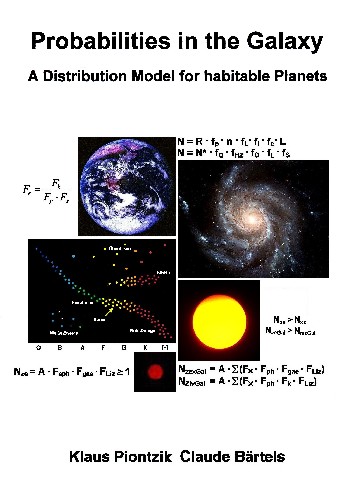With the probabilities determined
so far, it is possible to make a recalculation of how
many civilizations could have existed since the formation
of the galaxy. From this, a hypothetical rate of
civilization emergence can be determined, which
can provide information about the frequency of
intelligent life in the galaxy.
R is the mean star formation rate per
year in our galaxy. Depending on whether you are looking
at galaxies, star clusters, or stellar nebulae, the value
of R varies between 4
and 19. The mean is then 11,5.
[9]
Tg is the
age of our galaxy, at 13.2 billion
years.[10]
First, S is the number of stars that
have formed since the galaxy was formed.
The next step is to determine the
maximum number of civilizations that could have been
possible since the galaxy was born. In doing so, the
distant earth-like planets are taken as a measure.
Fia is the
probability of distant earth-like planets, with
intelligent life, in this galaxy. According to the
previous definitions and according to the rules of this
model, the probability is:
| |
Fia
= Fsph
· Fg
· Fa
· FL
· Fi |
Then the number M
of intelligent species formed in the time span Tg
can be determined as follows
| 7.4.2 Equation |
M
= S · Fia
M = R · Tg
· Fs
· Fp·
Fh·
Fg
· Fa
· FL
· Fi |
Equation 7.4.2 can still be
converted to:
| |
M
= R · Tg
· Fsph
· Fga
· FLi |
The values determined so far are used for the factors:
R = 11.5 mean star formation rate
Tg = 13.2 billion years, Age of our galaxy
Fs = 0.28 = 7:25 Sun-like star systems
Fp = 0.014,4 = 201:14,000 Star Systems with
Planets
Fh = 0.016,6 = 10:603 Planets in habitable
zones
Fg = 0.368,8 = 1,212:3,286 approximately
earth-great planets
Fa = 0.392,3 = 51:130 approximately earth-like
planets
FL = 0.111... = 1:9 planets with life
Fi = 0.071,4 = 1:14 Planets with intelligent
species
Fsph = 0.28 = 1:15,000
Fga = 0.142,8 = 1:7
FLi = 0.007,9 = 1:126
The following result is obtained by inserting the values
in equation 7.4.2. Since the formation of the galaxy, M
= 11,474 intelligent species have probably
emerged. This allows the average rate of civilization
development to be determined:
| 7.4.3 Equation |
 |
| |
 |
This results in an average rate of civilization
development of Z = 1.15 million years per
civilization.
The rate of civilization formation is the mean cycle time
between the appearance of two civilizations. This allows
for a general definition of old civilizations.
| 7.4.4 Definition |
A cycle of
civilization
is the period of time defined by the rate of
civilization development. |
| |
|
| 7.4.5 Axiom |
An old civilization is a
culture that has survived at least one cycle of
civilization. |
| |
|
| 7.4.6 Theorem |
An old civilization is a culture
that is at least 1.15 million years old. |
|
